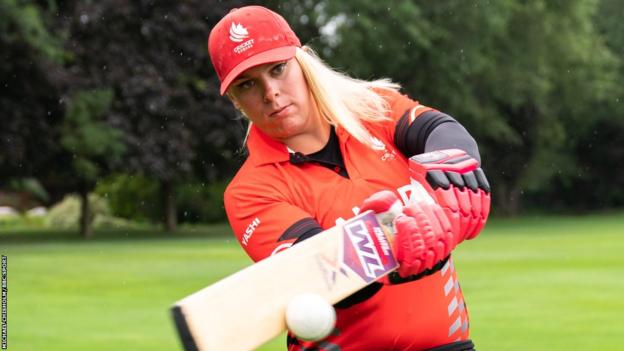[ad_1]

Canada’s Danielle McGahey is set to become the first transgender cricketer to play in an official international match.
McGahey has been included in Canada’s squad for a qualifying tournament on the pathway to the 2024 Women’s T20 World Cup in Bangladesh.
The 29-year-old opening batter has fulfilled all of the eligibility criteria the International Cricket Council (ICC) has for male-to-female transgender players before the event in Los Angeles from 4-11 September.
McGahey’s participation comes despite other sports – including athletics, cycling, swimming and both codes of rugby – banning transgender women from taking part in elite women’s competition.
A spokeswoman for the Women’s Rights Network (WRN) – a group which says it seeks to “defend the sex-based rights of women” – said transgender women had a “significant advantage” over athletes whose sex is recorded as female at birth, and called the ICC’s policy “unfair and unsafe”.
McGahey emigrated from Australia to Canada in February 2020, socially transitioned to a woman in November 2020 and started medically transitioning in May 2021.
McGahey told BBC Sport: “I am absolutely honoured. To be able to represent my community is something I never dreamed I would be able to do.”
What is the ICC’s stance on transgender women?
The ICC’s player eligibility regulations released in 2018 (and amended in 2021) state trans women wishing to play women’s international cricket must demonstrate “the concentration of testosterone in her serum has been less than 5 nmol/L1 continuously for a period of at least 12 months, and that she is ready, willing and able to continue to keep it below that level for so long as she continues to compete”.
The ICC also states a male-to-female trans player must “provide a written and signed declaration, in a form satisfactory to the designated medical officer, that her gender identity is female”.
McGahey said: “In order to determine [my testosterone levels], I’ve been doing blood tests every month now for over two years. I also have to put in my player profile who I have played against and how many runs I’ve scored.
“A lot of work with my doctor sending my medical information through to the ICC… they have a dedicated medical officer who looks over all of the information provided, and determines whether or not I have provided enough for an expert panel to make a decision.
“The need to do blood tests every month is probably the biggest challenge because when you are playing cricket you are travelling a lot.
“It’s very personal in terms of the information you are giving over – all your medical information, history of puberty, any surgeries. There’s a lot in it. But the protocols are there and it has been used as intended.”
WRN spokeswoman Jane Sullivan believes sporting categories should be kept separate on the basis of sex recorded at birth, and criticised the ICC for its eligibility criteria.
Sullivan told BBC Sport: “There are currently 17 peer-reviewed studies that show we cannot mitigate against male puberty when it comes to sporting performance.
“On average, men – however they identify – have bigger muscle mass, larger skeletons, bigger lung capacity, more fast-twitch muscles. It’s been proven that even 14-year-old boys can be faster and stronger than world-class female athletes.
“Any cricket team that has an individual who has been through male puberty already has an unfair advantage over an all-female side.
“As an organisation, we don’t want to see anyone banned from sport – it’s for everyone. But women’s sport must be fair – and safe – for the women taking part.”
In accordance with Cricket Canada’s regulations for domestic competitions, McGahey has been able to participate in the country’s women’s inter-provincial tournament based solely on gender self-identification.
Her performances with the bat brought her to the attention of the national team’s selectors and she played four international T20 matches in October 2022 at the South American Championships, where Canada were invited to take part as guests.
Those fixtures did not hold official T20 international status so she was free to play as a transgender woman without the need to fulfil any ICC criteria.
“Within five months of playing my first game with the women in Canada, I was in Brazil,” McGahey said.
“The board was all over it – ‘So OK, who is this?’ – and we kind of went from there. I basically got told two weeks before that I was going to be going to Brazil and representing Canada.
“Obviously I felt a huge sense of pride. Not only for what I’m doing, but for my [trans] community. Being able to represent them.”
McGahey’s place in Canada’s squad for the ICC T20 World Cup qualifying tournament was confirmed on 27 August.
An ICC statement said: “We can confirm that Danielle went through the process as required under the ICC’s player eligibility regulations and as a result has been deemed eligible to participate in international women’s cricket on the basis that she satisfies the MTF transgender eligibility criteria.”
A spokesperson for Cricket Canada said: “Danielle’s selection was based on ICC’s player eligibility regulations for male-to-female transgender players.
“Danielle sent through her application to the ICC and Cricket Canada followed the process as per the ICC rules, which made Danielle’s selection to the Canadian team possible.”
‘Treated like any other player’
McGahey is set to make her full T20 international debut for Canada against Brazil on the opening day of the four-team ICC Americas Qualifying tournament, which also features hosts USA and Argentina.
The winners of the event in California will progress to the Global Qualifier for the 10-team women’s T20 World Cup, where they will face Ireland and Sri Lanka plus the leading teams from the Asia, East Asia-Pacific, Europe and Africa regions.
Brazil’s women, who are all full-time professionals contracted by Cricket Brasil, played against McGahey and her team-mates in Rio de Janeiro last year.
Brazil captain Roberta Moretti Avery said McGahey’s presence on Canada’s team had been discussed in the lead-up to this tournament, but she would be “treated just like any other player” when she plays at Woodley Park in Los Angeles.
Avery said: “In cricket we can only play what the rulemakers give us, and abide by the current rules. I don’t think the rule is perfect, but that is not the fault of any individual player.
“I think we are going to see a lot of how Dani will affect the game going forward. We don’t know what that is going to be like. The current situation, I think, is fair.”
Gemma Witcomb – an academic expert on the issue of gender identity in sport at Loughborough University – said fairness in sport “is not solely down to physiology” and the historical pre-eminence of men’s cricket compared to the women’s game plays a part.
“Trans women may reap the rewards of the greater investment in their early cricketing careers and possess some advantages related to these earlier experiences,” she said.
“For example, more opportunities both at school and recreationally, to learn, play, and hone their skills; better funded and equipped clubs; more invested coaches etc.
“Such factors – related to opportunity – are well accepted to influence all men’s and women’s experiences and outcomes in sport and so ignoring these would deny their importance.”
McGahey, who was born in Australia, played men’s club cricket in Melbourne and joined a local men’s team – Cavaliers CC – in Regina, Saskatchewan after moving to Canada and prior to transitioning.
“I came down to one session and the season was basically over,” McGahey said.
“But the next year came around and I had the itch. I reached out and said: ‘Hey, you saw me once last year. I look a little bit different now, I go by Danielle.’
“I was hoping no-one remembered me, but they all did. It was really, really nerve-wracking.”
McGahey said she had not encountered any animosity from either team-mates or opponents since she started playing women’s cricket.
“I can’t recall a single negative experience, particularly on the field or off the field with my team. Everyone has been incredibly supportive,” McGahey said.
“I’m very open about my transitioning and for me it is all about inspiring the next and the next, and going from there.”
Avery felt there were “no issues” in terms of safety for the fielding team with McGahey’s batting, and the player’s part-time off-spin bowling is unlikely to be called upon by Canada captain Divya Saxena.
Avery did acknowledge it could be more difficult if a trans woman who had been through male puberty bowled significantly faster than typical speeds in women’s cricket.
According to Cricviz, the average speeds of balls delivered by seam bowlers in women’s T20Is from the period 2019-2023 inclusive was 64.4mph compared to 80.5mph for men.
Avery said: “I think when you start talking bowlers, and someone bowling at 135 or 140km/h [83 or 86mph], or something we don’t have in women’s cricket at this moment in time, the conversation may be different.
“I don’t think we have any examples of transgender women that bowl like that right now. But I do believe the world is changing.”
The ICC does include broader criteria for transgender cricketers in relation to safety on the field play.
The regulations state the governing body wants to “encourage and facilitate such participation” from transgender cricketers provided they “protect the safety of all participants” and “deliver on the promise of fair and meaningful competition offered by the division of the sport into male and female categories”.
‘The reality is cricket faces a choice…’
Canada, where one in every 300 people over the age of 15 are transgender or non-binary, has already had one high-profile transgender athlete in the spotlight this year.
Canadian footballer Quinn recently became the first transgender player to participate in a Fifa World Cup.
Quinn came out as non-binary in September 2020 and was permitted to play in accordance with Fifa’s existing regulations, which determine participation on the basis of sex assigned at birth rather than gender identity.
Fifa is taking guidance from legal, scientific and human rights experts as part of a review of its gender eligibility regulations for transgender athletes.
Other sports have been definitive with their stance on male-to-female transgender athletes participating in the women’s category, with arguments centred around fairness of competition:
The ICC’s regulations follow the framework on transgender athletes set out by the International Olympic Committee (IOC), which state there should be no assumption that a transgender athlete automatically has an unfair advantage in women’s sporting events.
Tommy Lundberg – assistant senior lecturer at the Karolinska Institute in Stockholm, who has undertaken academic research into the impact of testosterone reduction told BBC Sport: “In November 2021, the IOC did a 180-degree turn and now prioritises inclusion. I think it’s a very poor framework.
“Since then, however, several sports such as swimming, cycling and athletics have gone in the direction that World Rugby has gone in, and prioritised fairness.”
Lundberg also addressed the ICC’s criteria concerning eligibility, adding: “Many sports now do away with testosterone eligibility criteria, understanding from research that even suppressing testosterone to the female target of 1 nmol/L does not eliminate the male advantage.
“So cricket faces the reality that they have to choose between fairness and inclusion, because they cannot have both at the same time.”
The WRN believes the ICC’s decision to allow transgender women to participate shows they “haven’t woken up” to how “unfair and damaging their policies are for girls coming into the sport” despite admirable efforts to grow the game among women.
Sullivan added: “A growing number of sports are protecting the female category. Will parents look at the options and steer their girls away from sports, like cricket, that don’t appear to care about fairness and safety for their female players?
“Cricket could lose its grassroots with policies like this. And if you don’t have the grassroots, you don’t get the county players feeding through to the national teams.”
‘I’ve been playing a long time…’
Six years after the ICC established its criteria for the inclusion of transgender players in cricket, McGahey is poised to make her competitive debut.
And she is willing to respond to claims she has an advantage over her team-mates and opponents in women’s international cricket.
She believes any power or timing she has while batting have been honed from years of playing the game rather than the physiological benefits from male puberty.
“I can only speak about my journey. But the perceived strength advantage that trans women have is exactly that – it’s perceived,” McGahey said.
“I’ve been playing cricket for 25 years. I know if I’d just picked up a bat last week, I wouldn’t be able to hit the ball like I hit the ball.”
According to Cricviz, the average distance of sixes hit by men in T20Is in the past five years is 80.2 metres and 69.74m for women.
McGahey could be banned in future if the ICC was to make a U-turn on its eligibility criteria and follow the precedents set by other sports with transgender women.
“What the ICC have done incredibly well, so far, is they have their policy and they have stuck by it and aligned it with the IOC,” McGahey said.
“If cricket were to change it that would have an impact on me personally, but also on the next player and the player after that.”
McGahey’s family in her native Australia, meanwhile, are largely unaware of her life as a trans woman since she moved to Canada.
“The last communication I had with them was October 2021,” McGahey added.
“I knew [my feelings] from a very young age, but my family was the big reason I didn’t come out at a very young age. I knew their stance pretty early.
“The family that I have now is the family I’ve built; I can be happy with the people I have around me. They support me and back me all the way.
“Canada is very progressive. Obviously the initial part of transition is challenging, but once I started to have confidence in who I was life became pretty in easy in the sense I could just be who I am.
“I haven’t really had any backlash from anyone, even publicly for just expressing who I am. I went through university for a year, really open about who I am, and now cricket. So it’s been a really good journey.”

By Timothy Abraham
Source link




